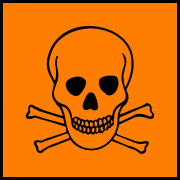
The EU's standard toxic symbol, as defined by Directive 67/548/EEC. Photo credit:
http://en.wikipedia.org/wiki/Poison
This article originally appeared on my ongoing series of articles for
Flexcin International, Inc as Pet Food Labels:
Bad Ingredients- BHA, BHT, Ethoxyquin, and Propylene Glycol
I encourage pet owners to scrutinize the ingredients listed on the labels of your pet’s food and treats. It is important to do this before any edible item enters the mouth of your companion animals.
I’ve introduced the importance of this topic in
Reading Pet Food Labels Can Save Lives, and dove head first into
Good Ingredients. Now let’s move onto the ingredients that are considered ‘bad’ as a result of their known toxic effects.
Ingredients to avoid:
Butylated Hydroxyanisole (BHA) and Butylated Hydroxytoluene (BHT)
- BHA and BHT are manufactured chemicals added to oils (fats) as preservatives. Both can be found in pet foods and treats.
- BHT is also a known carcinogen (source of cancer) and causes kidney and liver damage in rats. It has also been banned as a food preservative for humans in Australia, Japan, Romania, and Sweden; yet, it has not been banned for people or pets in the United States.
It is best that your pet’s food and treats have no preservatives at all, but vitamins C and E (tocopherols) are safer choices if there is no alternative.
Ethoxyquin
- Ethoxyquin is a chemical preservative that is illegal to use in human foods in the United States. Unfortunately, it can still be legally added to our pets’ meals to keep the fat therein “fresh”.
- It can be a direct component of food or will be present as part of fish meal (therefore may not even appear on a label). This is another reason why I suggest not feeding your pet a diet that includes any protein or grain ‘meals’ or ‘by products’.
- Human safety data reports Ethoxyquin to be harmful if it is swallowed or directly contacts skin.
Why should our pets be permitted to eat Ethoxyquin on a daily basis while knowing its toxic potential?
Propylene Glycol (PG)
- Propylene Glycol is a humectant, or moistening agent, found in certain soft dog treats (Bil-Jac, Pup-Peroni, etc). It is a chemical derivative of ethylene glycol (EG), also known as antifreeze, which is extremely toxic for any animal (or person) to consume.
- PG is touted as being non-toxic, tasteless, and unable to be absorbed by your pet, therefore it has a much higher margin for safety than ethylene glycol. Although PG is reportedly safer than EG, your pet’s health will not improve as a result of PG’s ingestion.
- PG was previously used in canned cat foods, but cats’ propensity to develop Heinz body anemia motivated the FDA to ban PG’s inclusion in feline products—it can still be found in dog food and treats. Consider that in a multi-pet household, a cat could potentially consume treats containing PG intended for a dog if they were accidentally left in an easily accessible location.
Just because a moist and meaty treat looks appealing (like real meat) does not mean it's a healthy option for your pet to consume. Avoid all meat simulations and instead offer small amounts of the real thing (low sodium turkey breast, etc.).
In learning more about pet food ingredients that are considered ‘bad’ (and in the next article where I will cover the ‘questionable’), ask yourself, “Am I willing to eat the foods I currently feed to my pet?” If the answer is no, then why is that particular treat or diet an appropriate choice for a beloved canine or feline companion?
Related Articles
Pet Food Ingredients: The Good
Why You Should Closely Scrutinize Your Pet’s Food and Treat Labels
Human Foods That Make Great Pet Treats
Thank you for reading my article. Your questions and comments are completely welcome (I’ll respond).
Please feel free to communicate with me through Twitter (
@PatrickMahaney) and follow my adventures in veterinary medicine by liking
Patrick Mahaney: Veterinarian Acupuncture Pain Management for Your Pets on Facebook.
Copyright of this article (2012) is owned by Dr Patrick Mahaney, Veterinarian and Certified Veterinary Acupuncturist. Republishing any portion of this article must first be authorized by Dr Patrick Mahaney. Requests for republishing must be approved by Dr Patrick Mahaney and received in written format.
 The EU's standard toxic symbol, as defined by Directive 67/548/EEC. Photo credit: http://en.wikipedia.org/wiki/Poison
This article originally appeared on my ongoing series of articles for Flexcin International, Inc as Pet Food Labels: Bad Ingredients- BHA, BHT, Ethoxyquin, and Propylene Glycol
I encourage pet owners to scrutinize the ingredients listed on the labels of your pet’s food and treats. It is important to do this before any edible item enters the mouth of your companion animals.
I’ve introduced the importance of this topic in Reading Pet Food Labels Can Save Lives, and dove head first into Good Ingredients. Now let’s move onto the ingredients that are considered ‘bad’ as a result of their known toxic effects.
Ingredients to avoid:
Butylated Hydroxyanisole (BHA) and Butylated Hydroxytoluene (BHT)
The EU's standard toxic symbol, as defined by Directive 67/548/EEC. Photo credit: http://en.wikipedia.org/wiki/Poison
This article originally appeared on my ongoing series of articles for Flexcin International, Inc as Pet Food Labels: Bad Ingredients- BHA, BHT, Ethoxyquin, and Propylene Glycol
I encourage pet owners to scrutinize the ingredients listed on the labels of your pet’s food and treats. It is important to do this before any edible item enters the mouth of your companion animals.
I’ve introduced the importance of this topic in Reading Pet Food Labels Can Save Lives, and dove head first into Good Ingredients. Now let’s move onto the ingredients that are considered ‘bad’ as a result of their known toxic effects.
Ingredients to avoid:
Butylated Hydroxyanisole (BHA) and Butylated Hydroxytoluene (BHT)
